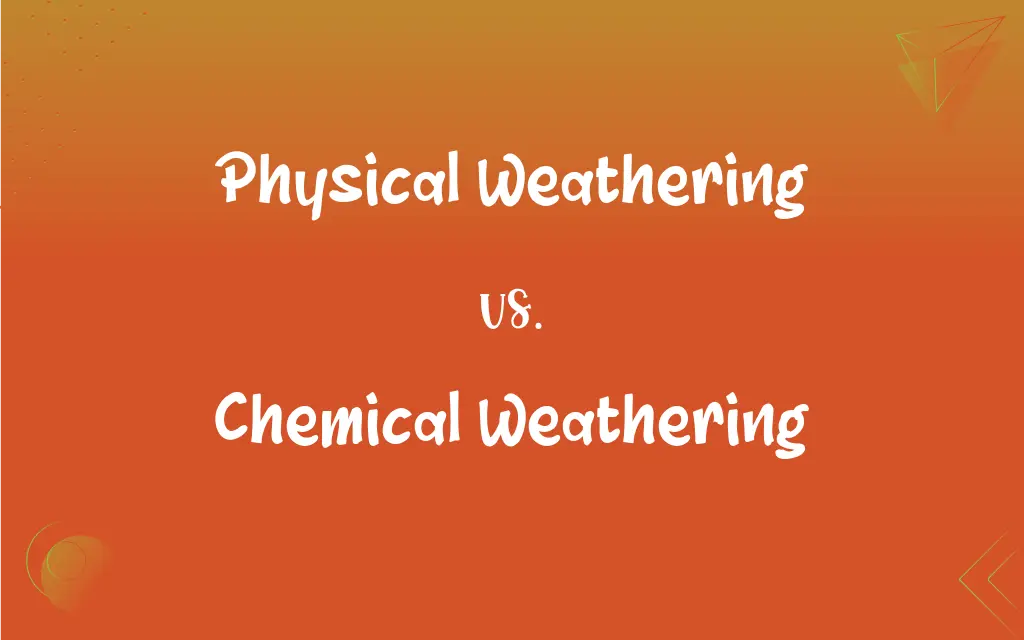Physical Weathering vs. Chemical Weathering: What's the Difference?
Edited by Janet White || By Harlon Moss || Updated on October 7, 2023
Physical weathering breaks down rocks through physical processes without changing their composition; chemical weathering alters the rock's mineral composition through chemical reactions.

Key Differences
Physical weathering involves the disintegration of rocks and minerals through direct contact with atmospheric conditions, such as heat, water, ice, and pressure. Chemical weathering, on the other hand, involves the decomposition of rocks and minerals by chemical reactions, often involving water and acids.
Examples of physical weathering include freeze-thaw cycles where water enters cracks, freezes, expands, and widens the cracks. In contrast, chemical weathering examples include reactions between rock minerals and acids, leading to the formation of new minerals and salts.
Over time, physical weathering can result in the fragmentation of rocks into smaller and smaller pieces without changing the chemical composition of the rock. In chemical weathering, the original rock minerals are altered, and the rock gradually changes in composition.
Both physical weathering and chemical weathering play crucial roles in the Earth's geological and climatic systems. While physical weathering contributes to soil formation by breaking down large rocks, chemical weathering can affect global carbon cycles by capturing and storing atmospheric carbon dioxide.
Factors like the type of rock, climate, and topography can influence whether physical or chemical weathering dominates in a particular region. For instance, in humid and warm climates, chemical weathering is often more prevalent due to increased moisture and higher temperatures facilitating chemical reactions.
ADVERTISEMENT
Comparison Chart
Primary Mechanism
Breakdown through direct atmospheric contact.
Decomposition through chemical reactions.
Examples
Freeze-thaw cycles, abrasion.
Reaction with acids, oxidation.
Result
Smaller rock fragments without compositional change.
Altered mineral composition with new mineral formation.
Factors Influencing
Climate, moisture, temperature variations.
Climate, presence of chemicals, moisture.
Impact on Environment
Contributes to soil formation.
Affects global carbon cycles by storing atmospheric CO2.
ADVERTISEMENT
Physical Weathering and Chemical Weathering Definitions
Physical Weathering
Weathering without altering the rock's inherent chemical composition.
The Grand Canyon's formation was significantly influenced by physical weathering from the Colorado River.
Chemical Weathering
The breakdown of rocks due to chemical reactions.
Limestone caves form largely due to chemical weathering from mildly acidic water.
Physical Weathering
Disintegration of rock due to atmospheric conditions.
Desert rocks often crack due to temperature variations causing physical weathering.
Chemical Weathering
The process where rock minerals react with external agents.
Chemical weathering by acid rain can damage historical monuments.
Physical Weathering
Fragmentation of rocks without any chemical change.
Wind abrasion in deserts causes physical weathering of exposed rock surfaces.
Chemical Weathering
Rock decomposition through reactions altering its mineral composition.
Rusting iron-rich rocks is a result of oxidation, a type of chemical weathering.
Physical Weathering
The mechanical breakdown of rocks into smaller particles.
River rocks are rounded due to the continuous physical weathering by flowing water.
Chemical Weathering
Alteration of rock substances through chemical processes.
Carbon dioxide from the atmosphere creates weak carbonic acid in rain, leading to chemical weathering.
Physical Weathering
The process through which rocks fracture, crumble, or disintegrate.
Ice wedging, where water freezes and expands in rock cracks, is a form of physical weathering.
Chemical Weathering
Transformation of rocks by changing their original minerals.
Granite can transform into clay through chemical weathering processes.
FAQs
What causes physical weathering?
Physical weathering is caused by direct atmospheric conditions such as heat, water, ice, and pressure.
Which type of weathering is dominant in warm, humid climates?
Chemical weathering is often more prevalent in warm, humid climates.
Which weathering type is prevalent in deserts?
Physical weathering, especially due to temperature variations, dominates in deserts.
Is salt crystallization a form of physical weathering?
Yes, as salt crystals grow in cracks, they exert pressure, causing the rock to fracture.
Which weathering type is mainly responsible for karst landscapes?
Chemical weathering, especially the dissolution of limestone by acidic water, forms karst landscapes.
What happens to feldspar during chemical weathering?
Feldspar can react with water and acids to form clay minerals.
How does chemical weathering alter rocks?
Chemical weathering changes the rock's mineral composition through chemical reactions.
Can both types of weathering occur on the same rock?
Yes, a rock can undergo both physical and chemical weathering simultaneously.
How do living organisms cause chemical weathering?
Organisms like lichens produce acids that can chemically weather rocks.
How does temperature influence physical weathering?
Temperature variations can cause rocks to expand and contract, leading to fractures.
Do chemical and physical weathering rates differ?
Yes, depending on factors like rock type, climate, and environment.
Why is understanding weathering important for geologists?
It helps in interpreting Earth's history, landscape evolution, and soil formation.
Why is oxidation considered chemical weathering?
Oxidation is a chemical reaction where minerals in rocks react with oxygen, changing the rock's composition.
Which weathering process contributes more to soil formation?
Both play roles, but physical weathering's breakdown of rocks is a primary contributor.
Do human activities influence chemical weathering?
Yes, pollution can lead to acid rain, which accelerates chemical weathering.
How does water facilitate both types of weathering?
Water causes physical weathering through actions like freeze-thaw and aids chemical reactions in chemical weathering.
Is erosion a type of physical weathering?
Erosion involves the movement of weathered particles, often resulting from physical weathering.
How does frost action contribute to physical weathering?
Water enters cracks, freezes, expands, and widens the cracks in a process known as freeze-thaw.
What's a common visual sign of chemical weathering on rocks?
Rust or color changes due to mineral alterations often indicate chemical weathering.
Can physical weathering change a rock's density?
No, physical weathering doesn't alter the rock's internal composition or density.
About Author
Written by
Harlon MossHarlon is a seasoned quality moderator and accomplished content writer for Difference Wiki. An alumnus of the prestigious University of California, he earned his degree in Computer Science. Leveraging his academic background, Harlon brings a meticulous and informed perspective to his work, ensuring content accuracy and excellence.
Edited by
Janet WhiteJanet White has been an esteemed writer and blogger for Difference Wiki. Holding a Master's degree in Science and Medical Journalism from the prestigious Boston University, she has consistently demonstrated her expertise and passion for her field. When she's not immersed in her work, Janet relishes her time exercising, delving into a good book, and cherishing moments with friends and family.































































